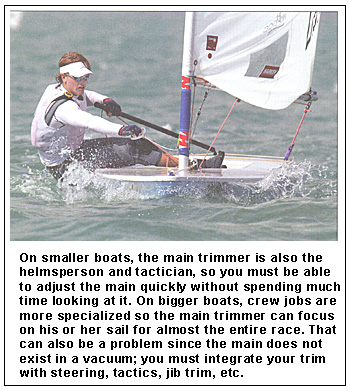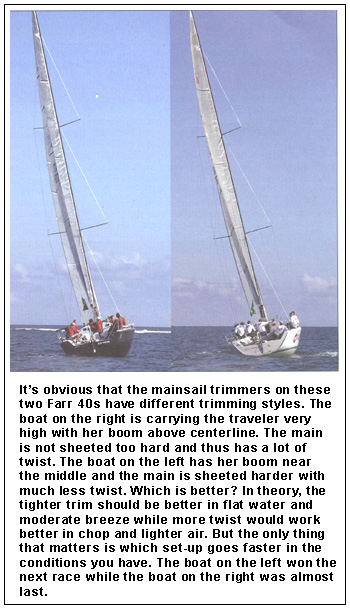|
Twenty Tips
for Mainsail Trimmers!
by David Dellenbaugh
On most boats, the mainsail is the biggest sail
and therefore affects your upwind speed more
than any other speed variable. It also has a lot
to do with pointing ability. So if you are the
person holding the mainsheet (whether you are
the helmsperson or a dedicated mainsail
trimmer), itís important to do as good a job as
possible.
Pre-race mainsail set-up
Like almost every other crew job, being a good
mainsail trimmer requires practice and
preparation to optimize performance. Here are
some things you can and should do before the
racing begins.
Telltales Place bright-colored telltales
on the aft end of the top two batten pockets.
These will tell you when the airflow around the
upper part of the sail is stalling.
Battens Be sure the battens are inserted
correctly and securely in their pockets. Use
stiffer battens in heavy air and bendier, more
tapered ones in light air (to avoid hard spots
at their inboard ends).
Sail controls Get familiar with all your
sail controls including outhaul, vang,
cunningham, backstay and traveler. Know where
each one leads and how to adjust it.
Set up all these control lines so they are
untangled, out of the way and even on each side.
Halyard Hoist the halyard so the head of
the main is all the way up to the black band.
After sailing for a while, check the halyard
again for possible stretch or slippage.
Flogging While sailing, try to minimize
the amount of time your mainsail is luffing so
you maintain the sailís shape as long as
possible. If you have a leech cord, set it just
tight enough to eliminate flutter.
Rig tuning The main trimmer is often
responsible for rig tuning as this has a large
impact on mainsail shape. Make sure you have
enough time before racing to check out the mast
on both tacks and make any adjustments
necessary.

Cleats On small boats, adjust your main
camcleat so the jaws are just below the sheet
when youíre holding it from a hiked-out
position. You want the cam low enough so the
sheet wonít cleat automatically, but high enough
so you can cleat it occasionally when you want.
Tuning Before the race, spend time
sailing upwind with another boat. Set up your
mainsail trim, and when you are going fast, put
a reference mark on the mainsheet. This is a
quick guide for getting your mainsail trim in
the ballpark while you are racing.
Go-fast trim guidelines
Trimming the main may seem like a challenge, but
if you follow a few guidelines, even an
inexperienced trimmer can make this sail go
fast.
Hold it! Donít cleat the sheet! The wind and
waves are always changing and require constant
adjustment of the sheet to keep the boat going
fast. Plus, holding the mainsheet is one of the
best ways to feel what the boat needs.
Traveler Set the traveler car so when you
trim the main (to the point where you have the
right twist ), the boom is roughly on the boatís
centerline. This is a good all-around trim
position. In light air, the traveler may have to
be all the way to windward. In ideal pointing
conditions, carry the boom above middle; when
youíre overpowered, start dropping it to
leeward.
Top batten twist Another good rule of
thumb is to trim your mainsheet so the upper
batten is parallel to the boom. In light or
lumpy conditions (or when youíre overpowered),
ease the sheet so the top batten falls off
slightly to leeward; in flat water and medium
winds, trim the sheet harder so the batten
actually angles to windward.
Twirling telltale When you have the right
amount of sheet tension, the telltale on the end
of the top batten should be twirling (stalling)
about half the time and streaming (flowing) the
rest. This is a rough guideline that works for
many boats most of the time. In ideal pointing
conditions, you can trim the sheet harder so the
top telltale is stalled almost all the time.
Helm The trim of your mainsail has a
large effect on windward helm and rudder angle.
When you want less helm (usually in strong
wind), make the main less powerful by easing the
sheet, adding twist, making the sail flatter and
so on. When you want more helm (e.g. for feel
and lift in light air), do the opposite.
Pointing The mainsail is your biggest
tool in the pointing-speed tradeoff. When you
want to go faster, drop the traveler to leeward
and/or ease the sheet. When you would rather
point higher, pull the traveler up and trim the
sheet. In general, the tighter your leech, the
more helm you will have and the higher you can
point. But make sure youíre going fast first.
Cunningham The purpose of the cunningham
is not to remove wrinkles from the luff of the
main - itís to adjust the fore-and-aft position
of the sailís draft. Pull it tighter to move
draft forward and make the sail flatter (usually
good ideas in breezes); ease the cunningham to
move the draft aft and make the sail fuller
(good in light air). Donít worry about wrinkles
- just go for the best shape and often you will
have some Ďspeed wrinkles.í
Backstay Use your backstay to control the
overall fullness of the mainsail. The harder you
pull on the backstay, the flatter your sail will
get. Just keep a few things in mind: 1) The
backstay also has a huge effect on the jib, so
make sure you coordinate any adjustments with
the jib trimmer; 2) Every time you adjust the
backstay, re-adjust the sheet and cunningham.
Overbend? When itís windy you may see
Ďoverbend wrinklesí extending from the lower
mainsail luff toward the clew. These indicate
that the mast is bent so much that the sailís
shape is turning inside out. If youíre
overpowered, itís good to see a hint of these
wrinkles so you know the sail is very flat. But
if these wrinkles show up too soon or are too
pronounced, take steps to reduce mast bend.
Shift gears Use your mainsheet like a
throttle. If the boat feels fast, trim the sheet
harder and go for more height. If the boat feels
slow, ease the sheet for acceleration, and bear
off slightly. Keep changing mainsail trim to
match the changing conditions.
Look around Spend time looking at how other
sailors trim their mainsails. Itís very helpful
to get in a motorboat and look at other boats.
Itís also a great idea for any trimmer to keep a
camera handy and take photos of the main when
the boat is fast (or slow).
Communicate Perhaps the most important
quality of all good sail trimmers is the effort
they make to communicate with other people on
the boat. The mainsail is just one part of a
complex speed package, so making the boat go
fast requires working closely with the skipper,
jib trimmer and crew who warn you about wind and
waves.

Dave publishes the newsletter Speed & Smarts.
For a subscription call: 800-356-2200 or go to:
www.speedandsmarts.com
TOP
|